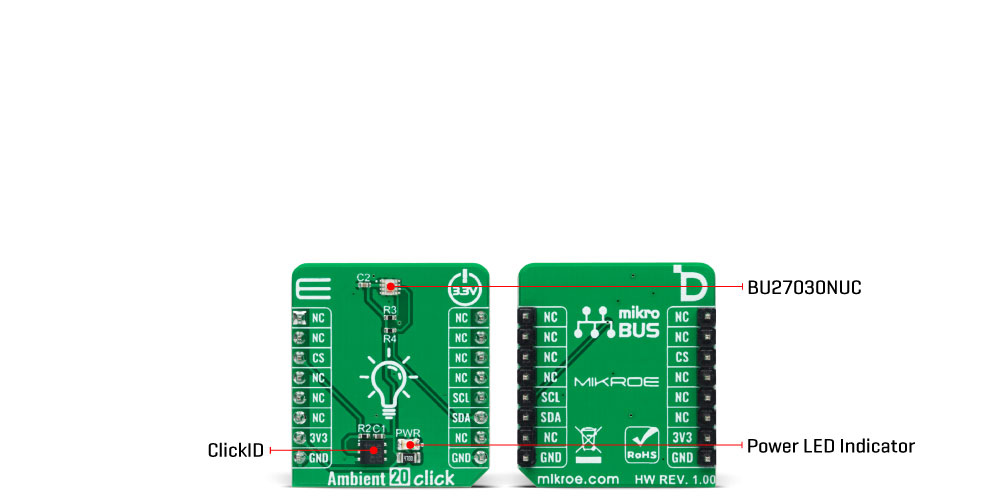20%
OFF
GO LOCAL
| Company | Stock | Price |
|---|---|---|

MIKROE-5469
16 g
Status:
Ambient 20 Click is a compact add-on board used to measure the amount of ambient light present. This board features the BU27030NUC, a 16-bit digital-output ambient light sensor with an I2C interface from Rohm Semiconductor. The BU27030NUC has a flexible and wide operating range of up to 20klx with a maximum resolution of 0.0007lux/count, providing an excellent responsivity close to a human eyes' response. It also features inherent 50Hz/60Hz light noise rejection and excellent IR-cut characteristics for high robustness at high sensitivity. This Click board™ is the most suitable for obtaining ambient light data in applications such as automatic residential and commercial lighting management.
Ambient 20 Click is fully compatible with the mikroBUS™ socket and can be used on any host system supporting the mikroBUS™ standard. It comes with the mikroSDK open-source libraries, offering unparalleled flexibility for evaluation and customization. What sets this Click board™ apart is the groundbreaking ClickID feature, enabling your host system to seamlessly and automatically detect and identify this add-on board.
This product is no longer in stock
Availability date:
20%
OFF
| Company | Stock | Price |
|---|---|---|

Ambient 20 Click is based on the BU27030NUC, a high-sensitivity light-to-digital converter from Rohm Semiconductor that transforms light intensity into a digital output signal. The BU27030NUC provides ambient light sensing (ALS) that approximates the human eye response to light intensity under various lighting conditions and through different attenuation materials. It has a flexible and wide operating range of up to 20klx with a maximum resolution of 0.0007lux/count, even when mounted behind dark glass. The BU27030NUC also features inherent 50Hz/60Hz light noise rejection and excellent IR-cut characteristics, making this board most suitable for brightness control functions, helping to reduce power consumption.

Ambient 20 Click communicates with an MCU using the standard I2C 2-Wire interface to read data and configure settings, supporting Standard Mode operation with a clock frequency of 100kHz and Fast Mode up to 400kHz. Despite its simple design, the BU27030NUC provides users with two outputs with different spectral responses. Thanks to the simplicity of the I2C interface, users can access not only the data of both outputs but also other configuration parameters such as the measurement mode of the desired output, gain settings, data update status, and the activation of the measurement process itself.
This Click board™ can only be operated from a 3.3V logic voltage level. The board must perform appropriate logic voltage level conversion before using MCUs with different logic levels. However, the Click board™ comes equipped with a library containing functions and an example code that can be used as a reference for further development.
Type
Optical
Applications
Can be used for applications such as automatic residential and commercial lighting management
On-board modules
BU27030NUC - ambient light sensor from Rohm Semiconducto
Key Features
Low power consumption, corresponds to a dark window because of high sensitivity, close responsivity to the human eye, I2C interface, wide operational range, stable performance over temperature, and more
Interface
I2C
Feature
ClickID
Compatibility
mikroBUS™
Click board size
S (28.6 x 25.4 mm)
Input Voltage
3.3V
This table shows how the pinout on Ambient 20 Click corresponds to the pinout on the mikroBUS™ socket (the latter shown in the two middle columns).
| Label | Name | Default | Description |
|---|---|---|---|
| LD1 | PWR | - | Power LED Indicator |
| Description | Min | Typ | Max | Unit |
|---|---|---|---|---|
| Supply Voltage | - | 3.3 | - | V |
| Spectral Range | 0 | - | 20.000 | lx |
| Resolution | - | 0.0007 | - | lx/count |
| Wavelength | 400 | - | 650 | nm |
We provide a library for the Ambient 20 Click as well as a demo application (example), developed using Mikroe compilers. The demo can run on all the main Mikroe development boards.
Package can be downloaded/installed directly from NECTO Studio Package Manager(recommended), downloaded from our LibStock™ or found on Mikroe github account.
Library Description
This library contains API for Ambient 20 Click driver.
Key functions
ambient20_sw_reset Software reset function.
ambient20_set_gain Set data gain function.
ambient20_read_data0 Read data0 function.
Example Description
This example demonstrates the use of Ambient 20 click board by measuring the ambient light level.
void application_task ( void )
{
// Task implementation.
uint16_t data0, data1;
ambient20_read_data0( &ambient20, &data0 );
ambient20_read_data1( &ambient20, &data1 );
log_printf( &logger, "Data 0: %d rn", data0 );
log_printf( &logger, "Data 1: %d rn", data1 );
Delay_ms( 1000 );
}
The full application code, and ready to use projects can be installed directly from NECTO Studio Package Manager (recommended), downloaded from our LibStock™ or found on Mikroe github account.
Other Mikroe Libraries used in the example:
Additional notes and informations
Depending on the development board you are using, you may need USB UART click, USB UART 2 Click or RS232 Click to connect to your PC, for development systems with no UART to USB interface available on the board. UART terminal is available in all Mikroe compilers.
This Click board™ is supported with mikroSDK - Mikroe Software Development Kit. To ensure proper operation of mikroSDK compliant Click board™ demo applications, mikroSDK should be downloaded from the LibStock and installed for the compiler you are using.
For more information about mikroSDK, visit the official page.
NOTE: Please be advised that any peripheral devices or accessories shown connected to the Click board™ are not included in the package. Check their availability in our shop or in the YMAN section below.